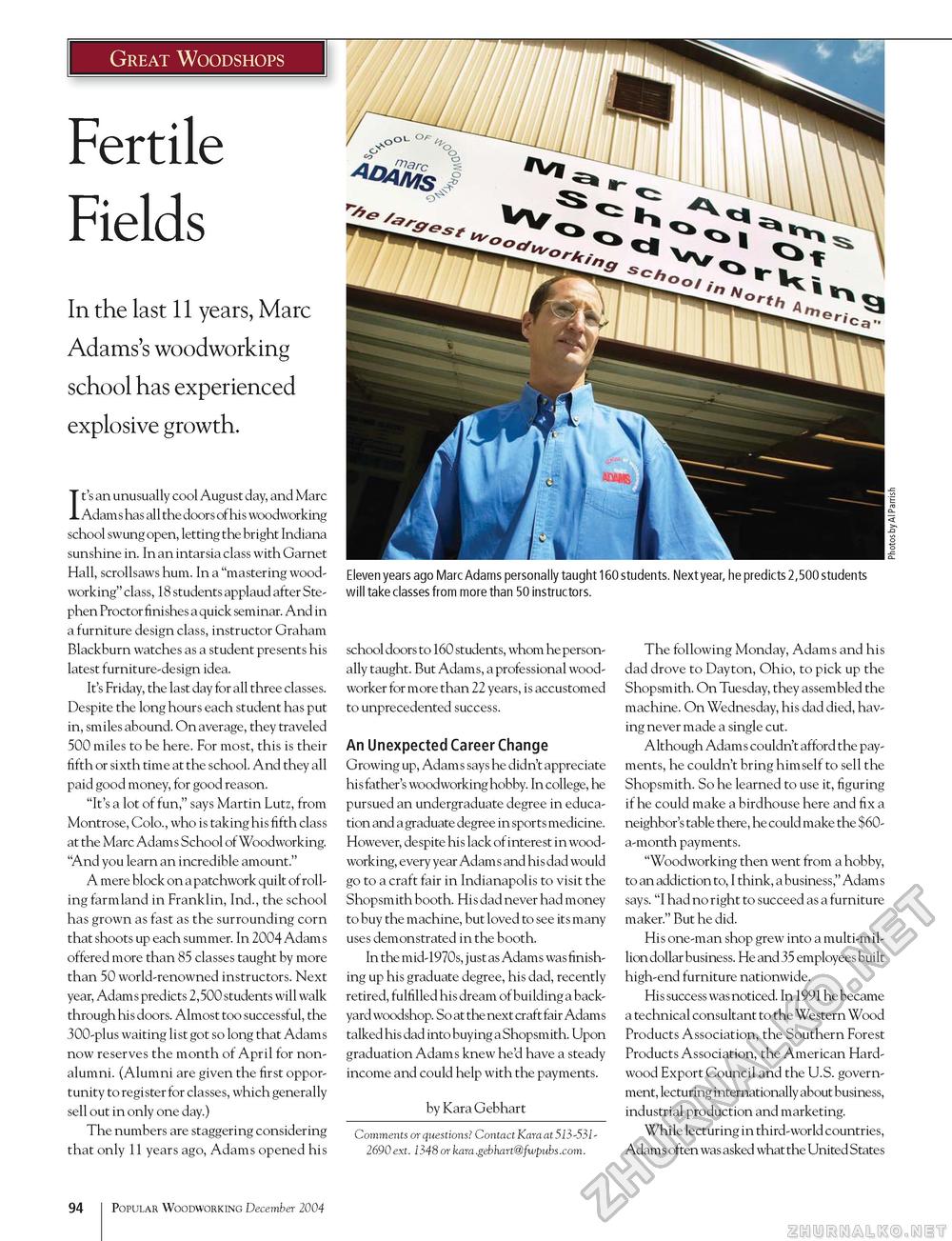Popular Woodworking 2004-12 № 145, страница 89
Great Woodshops Fertile Fields In the last 11 years, Marc Adams's woodworking school has experienced explosive growth. Eleven years ago Marc Adams personally taught 160 students. Next year, he predicts 2,500 students will take classes from more than 50 instructors. It's an unusually cool August day, and Marc Adam s has all the doors of his woodworking school swung open, letting the bright Indiana sunshine in. In an intarsia class with Garnet Hall, scrollsaws hum. In a "mastering woodworking" class, 18 students applaud after Stephen Proctor finishes a quick seminar. And in a furniture design class, instructor Graham Blackburn watches as a student presents his latest furniture-design idea. It's Friday, the last day for all three classes. Despite the long hours each student has put in, smiles abound. On average, they traveled 500 miles to be here. For most, this is their fifth or sixth time at the school. And they all paid good money, for good reason. "It's a lot of fun," says Martin Lutz, from Montrose, Colo., who is taking his fifth class at the Marc Adams School of Woodworking. "And you learn an incredible amount." A mere block on a patchwork quilt of rolling farmland in Franklin, Ind., the school has grown as fast as the surrounding corn that shoots up each summer. In 2004 Adam s offered more than 85 classes taught by more than 50 world-renowned instructors. Next year, Adams predicts 2,500 students will walk through his doors. Almost too successful, the 300-plus waiting list got so long that Adams now reserves the month of April for non-alumni. (Alumni are given the first opportunity to register for classes, which generally sell out in only one day.) The numbers are staggering considering that only 11 years ago, Adams opened his school doors to 160 students, whom he personally taught. But Adams, a professional woodworker for more than 22 years, is accustomed to unprecedented success. An Unexpected Career Change Growing up, Adams says he didn't appreciate his father's woodworking hobby. In college, he pursued an undergraduate degree in education and a graduate degree in sports medicine. However, despite his lack of interest in woodworking, every year Adams and his dad would go to a craft fair in Indianapolis to visit the Shopsmith booth. His dad never had money to buy the machine, but loved to see its many uses demonstrated in the booth. In the mid-1970s, just as Adams was finishing up his graduate degree, his dad, recently retired, fulfilled his dream of building a backyard woodshop. So at the next craft fair Adams talked his dad into buying a Shopsmith. Upon graduation Adams knew he'd have a steady income and could help with the payments. by Kara Gebhart Comments or questions? Contact Kara at 513-5312690 ext. 1348 or kara.gebhart@fwpubs.com. The following Monday, Adams and his dad drove to Dayton, Ohio, to pick up the Shopsmith. On Tuesday, they assembled the machine. On Wednesday, his dad died, having never made a single cut. Although Adams couldn't afford the payments, he couldn't bring himself to sell the Shopsmith. So he learned to use it, figuring if he could make a birdhouse here and fix a neighbor's table there, he could make the $60-a-month payments. "Woodworking then went from a hobby, to an addiction to, I think, a business," Adams says. "I had no right to succeed as a furniture maker." But he did. His one-man shop grew into a multi-million dollar business. He and 35 employees built high-end furniture nationwide. His success was noticed. In 1991 he became a technical consultant to the Western Wood Products Association, the Southern Forest Products Association, the American Hardwood Export Council and the U.S. government, lecturing internationally about business, industrial production and marketing. While lecturing in third-world countries, Adams often was asked what the United States 94 100 Popular Woodworking December 2004 |








